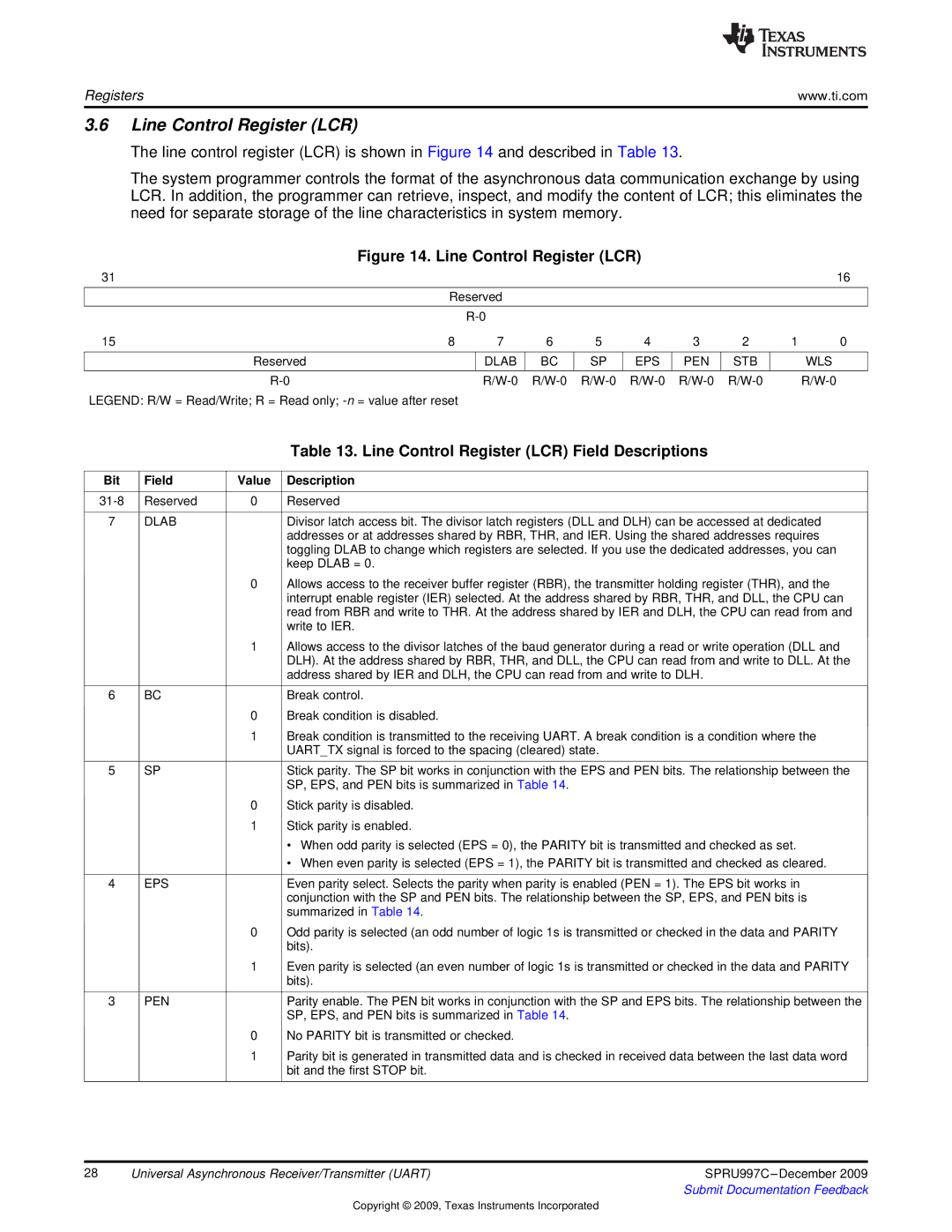
Registers | www.ti.com |
3.6Line Control Register (LCR)
The line control register (LCR) is shown in Figure 14 and described in Table 13.
The system programmer controls the format of the asynchronous data communication exchange by using LCR. In addition, the programmer can retrieve, inspect, and modify the content of LCR; this eliminates the need for separate storage of the line characteristics in system memory.
Figure 14. Line Control Register (LCR)
31 |
|
|
|
|
|
|
|
|
| 16 |
| Reserved |
|
|
|
|
|
|
| ||
|
|
|
|
|
|
|
|
|
| |
|
|
|
|
|
|
|
|
| ||
15 | 8 | 7 | 6 | 5 | 4 | 3 | 2 | 1 | 0 | |
|
|
|
|
|
|
|
|
|
|
|
Reserved |
|
| DLAB | BC | SP | EPS | PEN | STB |
| WLS |
|
|
|
|
|
|
|
|
|
|
|
|
|
| ||||||||
LEGEND: R/W = Read/Write; R = Read only; |
|
|
|
|
|
|
|
|
| |
|
|
| Table 13. Line Control Register (LCR) Field Descriptions |
|
|
|
|
Bit | Field | Value | Description |
|
|
|
|
Reserved | 0 | Reserved | |
|
|
|
|
7 | DLAB |
| Divisor latch access bit. The divisor latch registers (DLL and DLH) can be accessed at dedicated |
|
|
| addresses or at addresses shared by RBR, THR, and IER. Using the shared addresses requires |
|
|
| toggling DLAB to change which registers are selected. If you use the dedicated addresses, you can |
|
|
| keep DLAB = 0. |
|
| 0 | Allows access to the receiver buffer register (RBR), the transmitter holding register (THR), and the |
|
|
| interrupt enable register (IER) selected. At the address shared by RBR, THR, and DLL, the CPU can |
|
|
| read from RBR and write to THR. At the address shared by IER and DLH, the CPU can read from and |
|
|
| write to IER. |
|
| 1 | Allows access to the divisor latches of the baud generator during a read or write operation (DLL and |
|
|
| DLH). At the address shared by RBR, THR, and DLL, the CPU can read from and write to DLL. At the |
|
|
| address shared by IER and DLH, the CPU can read from and write to DLH. |
|
|
|
|
6 | BC |
| Break control. |
|
| 0 | Break condition is disabled. |
|
| 1 | Break condition is transmitted to the receiving UART. A break condition is a condition where the |
|
|
| UART_TX signal is forced to the spacing (cleared) state. |
|
|
|
|
5 | SP |
| Stick parity. The SP bit works in conjunction with the EPS and PEN bits. The relationship between the |
|
|
| SP, EPS, and PEN bits is summarized in Table 14. |
|
| 0 | Stick parity is disabled. |
|
| 1 | Stick parity is enabled. |
|
|
| • When odd parity is selected (EPS = 0), the PARITY bit is transmitted and checked as set. |
|
|
| • When even parity is selected (EPS = 1), the PARITY bit is transmitted and checked as cleared. |
|
|
|
|
4 | EPS |
| Even parity select. Selects the parity when parity is enabled (PEN = 1). The EPS bit works in |
|
|
| conjunction with the SP and PEN bits. The relationship between the SP, EPS, and PEN bits is |
|
|
| summarized in Table 14. |
|
| 0 | Odd parity is selected (an odd number of logic 1s is transmitted or checked in the data and PARITY |
|
|
| bits). |
|
| 1 | Even parity is selected (an even number of logic 1s is transmitted or checked in the data and PARITY |
|
|
| bits). |
|
|
|
|
3 | PEN |
| Parity enable. The PEN bit works in conjunction with the SP and EPS bits. The relationship between the |
|
|
| SP, EPS, and PEN bits is summarized in Table 14. |
|
| 0 | No PARITY bit is transmitted or checked. |
|
| 1 | Parity bit is generated in transmitted data and is checked in received data between the last data word |
|
|
| bit and the first STOP bit. |
|
|
|
|
28 | Universal Asynchronous Receiver/Transmitter (UART) | SPRU997C |
|
| Submit Documentation Feedback |
Copyright © 2009, Texas Instruments Incorporated
